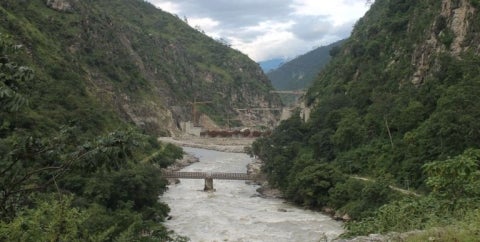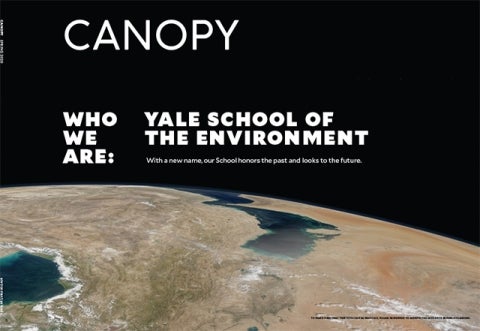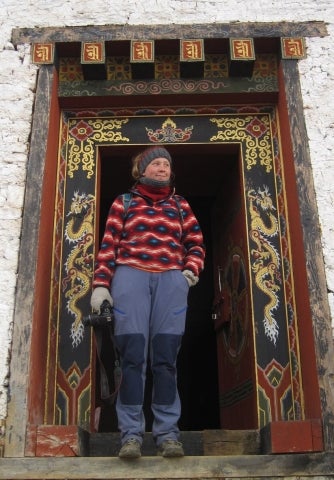Note: Yale School of the Environment (YSE) was formerly known as the Yale School of Forestry & Environmental Studies (F&ES). News articles and events posted prior to July 1, 2020 refer to the School's name at that time.
 <div id="cell_12924"> <div id="image_00017508"> <div> An upstream view of the dam construction work at the Punatsangchhu-II Hydropower Plant, one of the two major new projects under construction. </div> <div> </div> </div></div><div id="cell_12923"> </div>
<div id="cell_12924"> <div id="image_00017508"> <div> An upstream view of the dam construction work at the Punatsangchhu-II Hydropower Plant, one of the two major new projects under construction. </div> <div> </div> </div></div><div id="cell_12923"> </div>
The rush of water ripped through the valley like an excavator. After an unusually heavy monsoonhad created an artificial lake behind a wall of debris,a sudden collapse of that temporary dam on Aug. 6,2019 sent water gushing down a steep hillside abovethe Punatsangchhu River in Bhutan.
Before joining F&ES, Emma Johnson ’20 M.E.M. spent a year in Bhutan, where she helped coordinate The School for Field Studies study abroad program and studied youth perceptions of climate change and the environment. Last summer, she returned to report this article with support from the Pulitzer Center on Crisis Reporting, where she was a Reporting Fellow, and the Yale Program on Climate Change Communication.
Boulders the size of buses tore through everything in their path. All that remained of a concrete bridge were the pillars on either end. Whole trees lay like toothpicks. Downstream, where this unusually small river joins the much bigger Punatsangchhu, it was chaos. Debris blocked the river, flooding the main highway.
The sudden floods on the Punatsangchhu were likely driven by the kind of extreme monsoon event that is becoming more common as a result of climate change.
As the climate warms, Bhutan may have more seasons of extremes: summers of flooding, intense monsoons, and glacier dam bursts, followed by winters of drought. Because Bhutan is heavily dependent on rivers and the electricity they generate through hydropower — for their own development and to generate revenue from electricity-hungry India— shifts in climate will have implications for the country’s international relations.
Many Bhutanese are grappling with how to grow their country in the face of these changes.
PERILS OF GEOGRAPHY
Imagine a flat piece of paper, then imagine crushing it into a ball. This is Bhutan’s geography. Steep valleys descend into deep river gorges and climb back up. Defining the valleys are the rivers: originating amidst the peaks of Tibet or Bhutan, rivers weave downward to Bhutan’s central temperate belt before cascading through the tropical south and into India.
 This article was originally published in the <a href="/alumni/publications">Spring 2020 issue of <em>Canopy</em></a> magazine.
This article was originally published in the <a href="/alumni/publications">Spring 2020 issue of <em>Canopy</em></a> magazine.
The rivers look different between winter and summer. Winter means drought when rains rarely fall and the water in the north is locked up in ice. The rivers flow at a fraction of their full volume. In summer, the Himalayan glaciers — the world’s “Third Pole” — are melting faster every year, pouring water into Bhutan’s rivers. Add to this the erratic Indian monsoon, which instead of bringing steady rain over a few months, as it once did, now dumps water in intense, irregular bursts. The result? Raging rivers ready to sweep away anything in their path.
“More and more people are thinking that winter will be drier, summer will be wetter with more floods and irregular rains, so we need to control the water that is coming down,” says Chhewang Rinzin, Managing Director of the Druk Green Power Corporation, Bhutan’s primary hydropower company.
Hydropower dams typically found in Bhutan are not like the large structures that span rivers in many parts of the world. These are run-of-the-river schemes, which means that water mostly flows through them rather than being stored behind them.
These dams may make Bhutan’s economy more vulnerable to climate change. Since the dams don’t actually store water, the energy production changes with the season: in the winter, when the river is low, the plants can only produce a fraction of their full capacity. But in the summer, with melting glaciers and the monsoon, most of the water must run through or past the dam without generating electricity because the plants can’t accommodate such extreme flows of water. Summers also bring more flash floods, which means more debris cascading downstream, blocking and damaging the dam.
“What is going to happen when the glacier melts, when the snow melts, when the monsoons are not the monsoons that we are used to?” Rinzin asks. “Can the hydropower stations for which we have invested so much money be sustained?”
CHALLENGES BEYOND SOLUTIONS
There’s no straightforward climate mitigation answer in Bhutan. From the outset, “it is unpredictable because the microclimate conditions are very different than the regional climate conditions,” explains Om Katel, Dean and Professor at the College of Natural Resources in Punakha. This also presents a challenge for modeling future climate changes. The country had no accurate weather stations until 1995, so any climate predictions use global models, which lack the resolution to take Bhutan’s extreme geographical variation into account.
And even if there were clear solutions, that wouldn’t be enough: “The biggest challenge is the implementation — there are no resources,” says Tenzin Wangmo, the Chief Climate Officer at the National Environmental Commission.
Struggling with a lack of capacity and knowledge is especially difficult when Bhutan is not responsible for climate change in the first place. As a carbon-negative country, Bhutan actually has enough tree cover to compensate for its own emissions. By contrast, Bhutan’s neighbors, China and India, rank first and third, respectively, in terms of national greenhouse gas emissions. “We have done nothing,” Wangmo remarks, “but carbon has no border.”
A STABLE ECONOMY IN AN UNCERTAIN FUTURE
“We are a hydropower rich country,” states Mewang Gyeltshen, Director of the Department of Renewable Energy. In 2018, hydropower generation made up 13 percent of Bhutan’s GDP. That is only expected to grow as more plants are built.
 Emma Johnson in Bhutan
Emma Johnson in Bhutan
“The whole economy is dependent on hydropower,” adds Wangmo. “And climate change will definitely impact hydropower. That is why it is our biggest worry.”
Gyeltshen and his team have assessed sites for solar and wind projects in hopes of diversifying the economy, but with hydropower electricity being as cheap as it is, “we see these projects being more as a Plan B,” he says.
The logical next question then is diversifying to what. Perhaps more tourism, other industries, cryptocurrencies. But, Rinzin reminds bluntly, “we should not forget that any diversification work that you do will need electricity. And the only source we have today is hydropower.”
And so Bhutan continues to make huge investments in hydropower. Sitting in her small office in Thimphu, the country’s growing capital, Wangmo worries aloud. “If in 30 years this water dries up, what do we do?”
This is an adaptation of an article published on the site Mongabay.
 <div id="cell_12924"> <div id="image_00017508"> <div> An upstream view of the dam construction work at the Punatsangchhu-II Hydropower Plant, one of the two major new projects under construction. </div> <div> </div> </div></div><div id="cell_12923"> </div>
<div id="cell_12924"> <div id="image_00017508"> <div> An upstream view of the dam construction work at the Punatsangchhu-II Hydropower Plant, one of the two major new projects under construction. </div> <div> </div> </div></div><div id="cell_12923"> </div>
 This article was originally published in the <a href="/alumni/publications">Spring 2020 issue of <em>Canopy</em></a> magazine.
This article was originally published in the <a href="/alumni/publications">Spring 2020 issue of <em>Canopy</em></a> magazine.
 Emma Johnson in Bhutan
Emma Johnson in Bhutan